Welcome!This page is dedicated to documenting me and my team’s IMA Group Project.
For this project we were required to create a futuristic interactive artifact based on a fictional story setting. The artifact had to be made of cardboard and with no electronics or advanced technology within. After it was done, we had to do a performance to showcase the artifact. The story we picked is “The Veldt” which is a story about two children who killed their parents so they can continue to enjoy the virtual reality room. Our team proposal was that after the parents are dead, the two children will be bored and need a machine to fulfill their desire. This was where our team artifact comes in which is a TV like machine that can create items based on the users thoughts. Through a headset that can read users thoughts, thoughts can be transferred to the “TV” which will create it for the user after the user turns its knob.
As we have learned in class, a good interaction design should meet three principles: Affordances, Predictability, Feedback. The artifact we created fits the definitions of interaction as it meets all three principles. For affordances, our design was simple and operates based on its nature of design. The headphone was for wearing, button for pressing and knob for tuning. There was no need for a guide as users will understand how to use it after a few tries. For predictability, this machine did not need prior knowledge and its function is predictable. Users only need to input thoughts to the machine and the machine will give feedback through creating the items. For feedback, our design was to give timely and relevant feedback to the user. Users would have known something is created after they turn the knob. Furthermore, they would have understood immediately that their thoughts will turn into actual items through this machine. Overall, I believe that our artifact meets the definitions of good interaction.
I believe our artifact is a success as it is something I forsess will be developed in the future. Even though its function might not be exactly like ours, our cardboard idea could pave the way for it to be invented. The artifact we created demonstrated clearly to the audience how it functioned and what it could do. I view that our artifacts embodied what cardboard design is, which is a prototype for the actual products.
Our building process and some of my contributions:
For our team we had five person: Me, Yunni, Haotong, Peirong, Malaine
Step 1: Brainstorm
After setting a meeting time on Wechat, we did a team brainstorm of ideas we wrote and picked Haotong’s idea of a “TV” that can create items based on our imagination. At this point we have not yet defined how our products can turn imagination into physical items. Below was a sketch by Haotong on the artifact appearance.
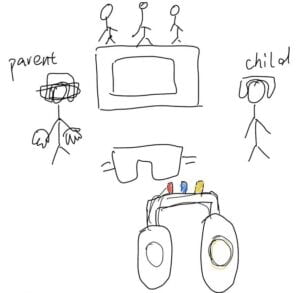
I told my team that we only have to create an artifact based on the story setting, not necessarily connecting to the plot. This is where we start to explain how our artifacts function. As there could be no mind reading for this project, we created a headphone to read the person’s brain wave for desire. The headphone interprets the brain wave then picks the item most relevant to it. It then passes the information to the “TV” shape machine which will create it for the user.
Step 2: Creation
Beginning of creating props:
During our first meeting, we decided that we will start Cutting cardboard to form the shape of a TV. Furthermore we decided that we will finish each step together to be more efficient. During this meeting we finished the “TV” rough appearance.
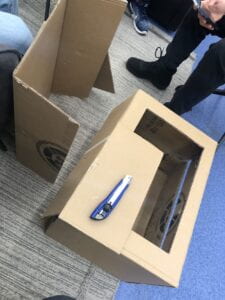
Building the headphone:
During our second meeting, we started working on headphones. Me, Peirong, Haotong worked on the headphone while Malaine and Yunni finished the “TV”. The picture below was us cutting cardboard to form the headphone. Through our collaboration, we finished the entire artifact in this meeting.
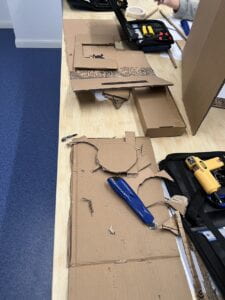
Taping the “TV” bottom together
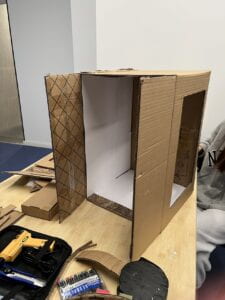
Step 3: Finished products:
“TV” (With buttons, Turnable knob, and the Headphone rack)
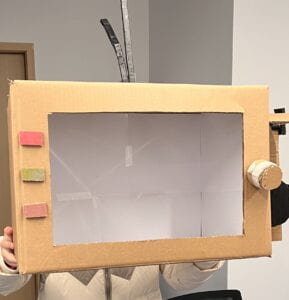
Headphone (Can understand users thoughts and transfer it to the “TV”)
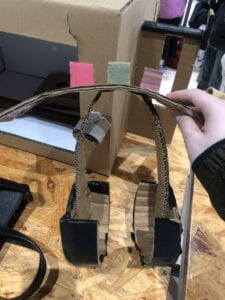
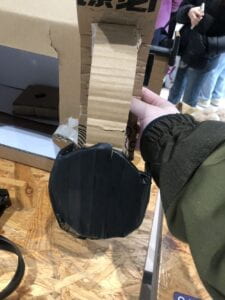
Headphone and “TV” combined
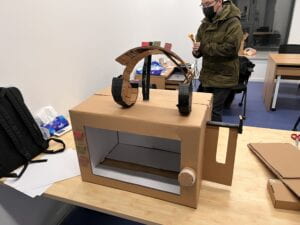
Step 4: Our team performance
For the performance, we decided to divide roles. Malaine acted as a stand that held the “TV” up. Peirong, Haotong and Yunni acted as users who have a desire for a certain item. I acted under the “TV” to materialize their thoughts through putting items in the “TV”.
Impression of other team:
Apart from our team, a team that left me a strong impression is the group that created a magic door. Their performance was very innovative as it combines the actual machine and props to form a setting for the audiences. I really liked the use of cardboard Egypt pyramids and Oriental Pearl Tower to demonstrate the location for the audience. Their artifact was a futuristic door that can allow the user to travel to place though the door in an instant. It acted as a portal that connects two places together which create unlimited options for the user. I think it fitted well with the fictional story of “The Veldt”. Technology in that story setting is far superior compared to now and people will have the desire to go to any place through a door. I believe it met the criteria as it is interactive. It was easy to use and can operate without any guide. Adding on to it there was “communication” between humans and machines. Humans give input to the machine through thinking about a location and the machine gives feedback of changing location based on the user’s desire. A suggestion for them is to speak louder next time during their performance. I have some difficulty hearing their speech as they are far away from me. If they pay more attention to this, their performance will improve greatly.